If you think about it, wild food is everywhere around us. Our backyards have dandelions growing so rampant, we constantly try to eradicate them.
Public fruit trees beg to be gleaned, miner’s lettuce is a weed with a gourmet reputation, easy hikes will bring you upon scores of stinging nettles and fennel.
Read more: Other common weeds that are actually edible
The East Coast has ramps springing up every year in shady woodlands. Northern California has chanterelles and blackberries in abundance.
And in Southern California, there’s Peruvian pepper, also known as the pink peppercorn tree. These are the same pink peppercorns you see in stores as a gourmet spice, packaged in small, expensive jars and called for in fancy cookbooks.
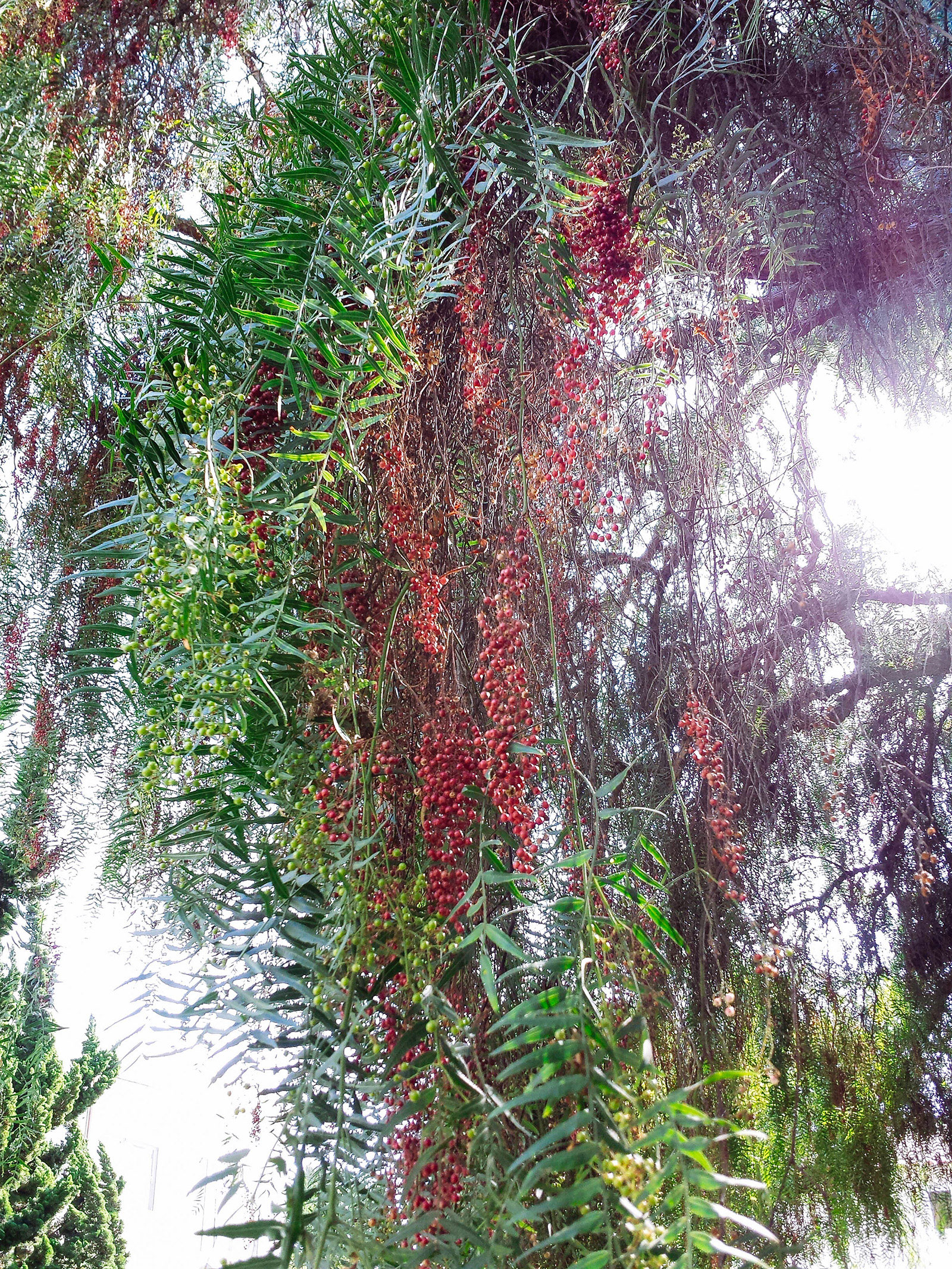

But in Southern California and other parts of the country, bucketfuls of these vibrant berries litter the ground in suburban neighborhoods all through fall and winter, free for the taking. More often than not, they’re dismissed as a nuisance by the gardener who has to rake them all up.
It almost seems like a food crime to let heaps of peppercorns lay forgotten when just a few miles away, they command upwards of $10 an ounce at specialty spice shops.
Because while they look like (and are often grown as) landscape ornamentals in residential backyards and municipal sidewalks, the pink peppercorns from Peruvian pepper trees are 100 percent edible!
Related: Common vegetables you grow that you didn’t know you could eat
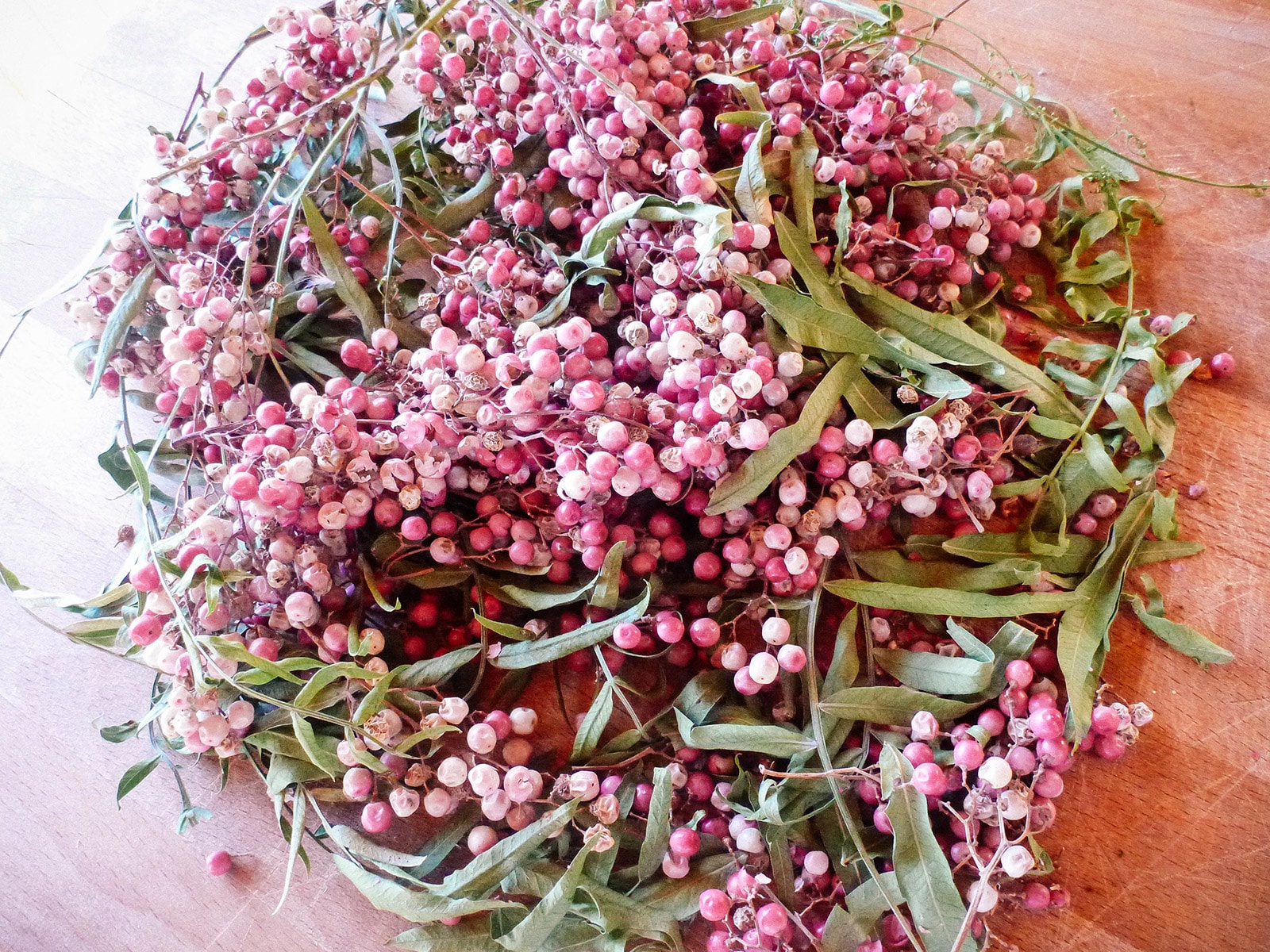
Peruvian pepper tree vs. Brazilian pepper tree
The classic pink peppercorn comes from the Peruvian pepper tree (Schinus molle), which is also called the California pepper tree (although it’s particularly invasive in Florida and Hawaii).
Peruvian pepper is not to be confused with its cousin, the Brazilian pepper tree (Schinus terebinthifolius), which has similar berries but rounder and wider leaves resembling holly. (And to make things more confusing, the pink peppercorns from Brazilian pepper trees are sometimes called Madagascar pepper—but they are one and the same.)
Though they are different species, the dried reddish-pink berries of both trees are used in commercial peppercorn blends, and are labeled interchangeably as “pink peppercorns” or “red peppercorns.”
The pink peppercorn tree featured here belongs to a friend and reaches over 30 feet in height—towering above his two-story home in Long Beach, California. Its drooping growth habit reminds me a lot of weeping willow, with evergreen branches that dangle with clusters of pink berries.
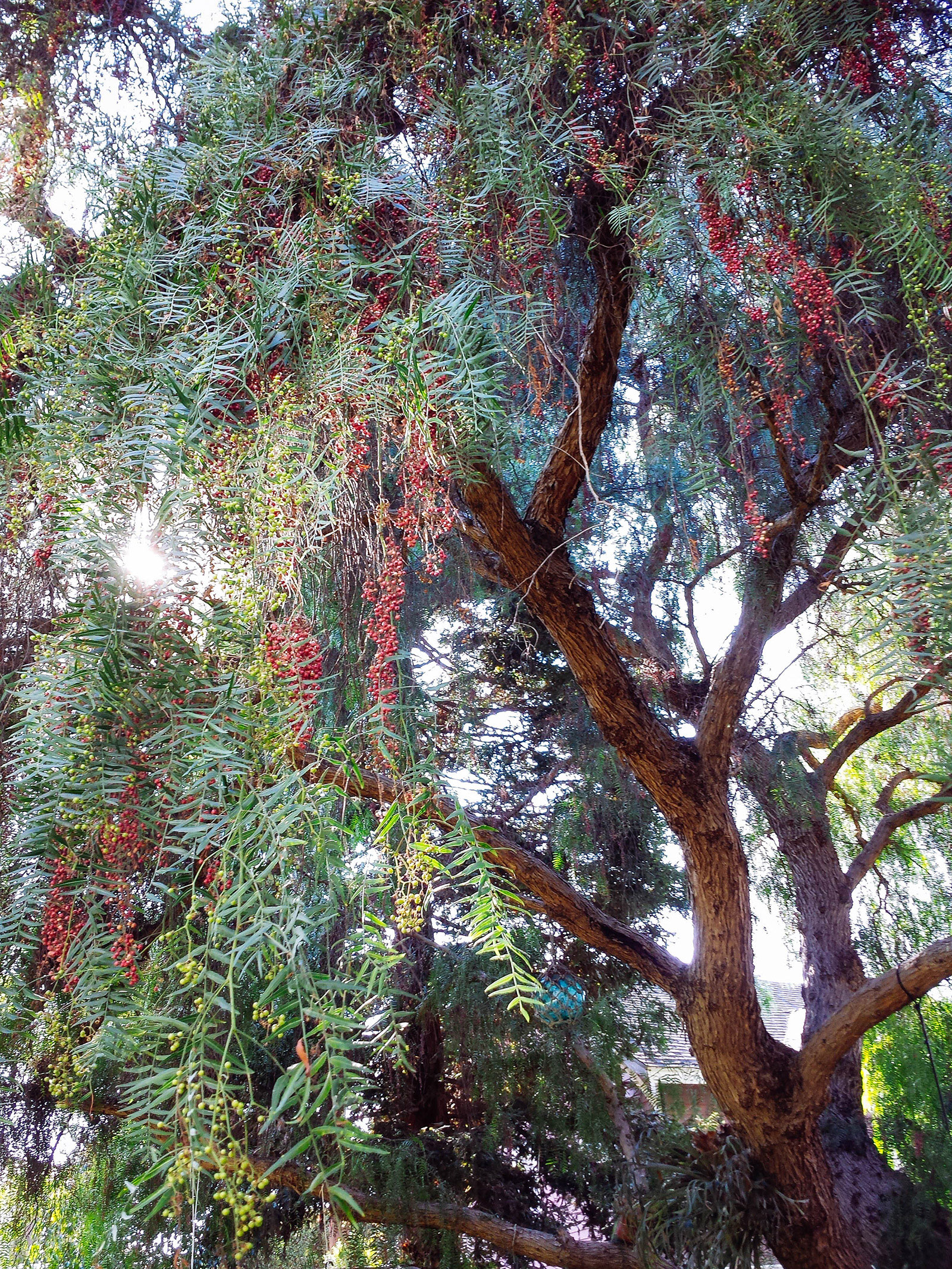
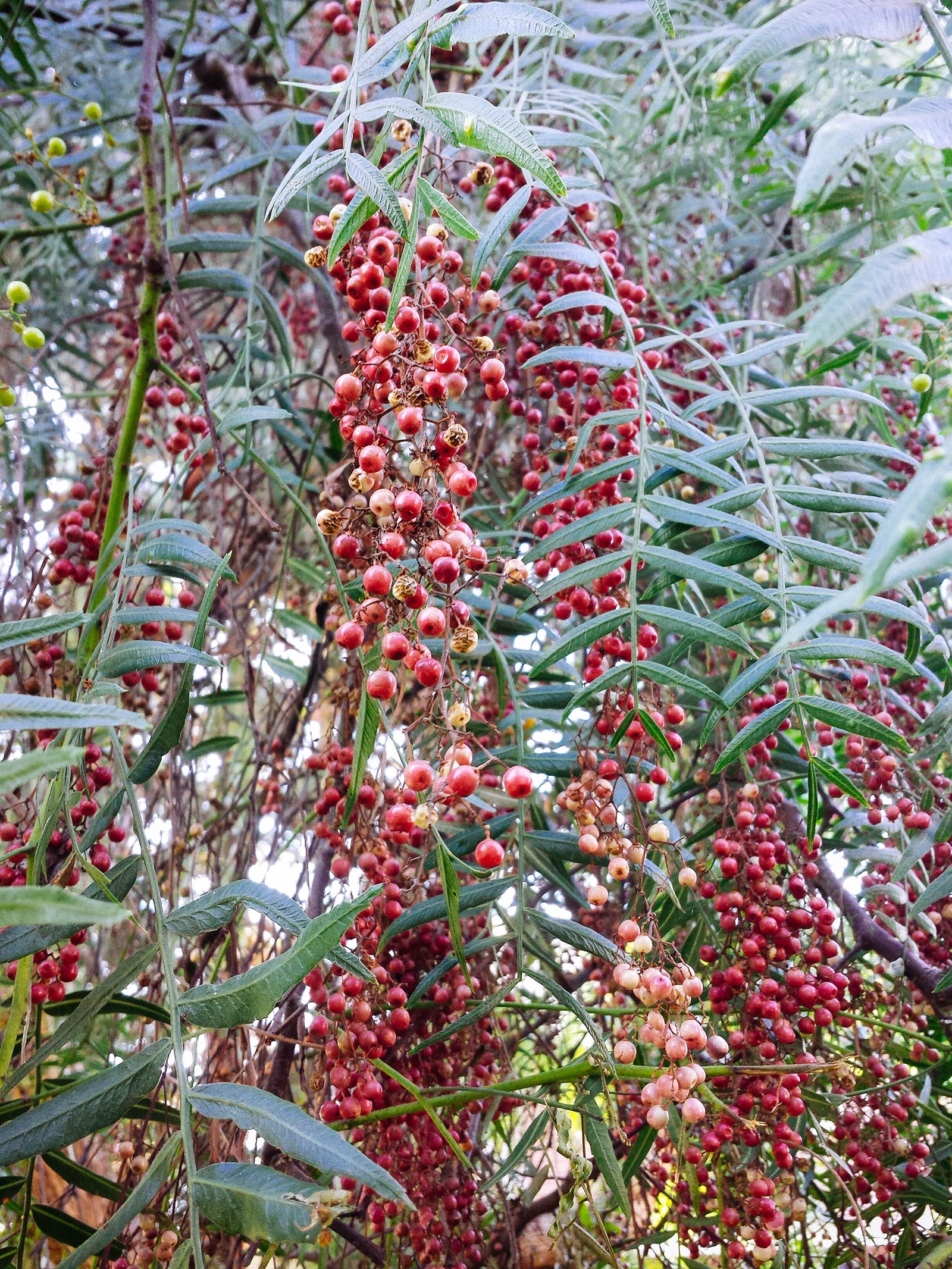
The berries are known as drupes, or fruits that bear a single seed. The hard, woody seed (wrapped inside a papery pink husk) is the “peppercorn,” though Peruvian pepper is not an actual pepper at all.
Pink peppercorn has no relation to the green, black, or white peppercorn berries (Piper nigrum, or true pepper) grown throughout Asia and used as a spice. It’s known as a “false pepper” and is actually a member of the cashew family.
(This connection to cashews is what gives pink peppercorns an unfair reputation as being poisonous—more on that below.)
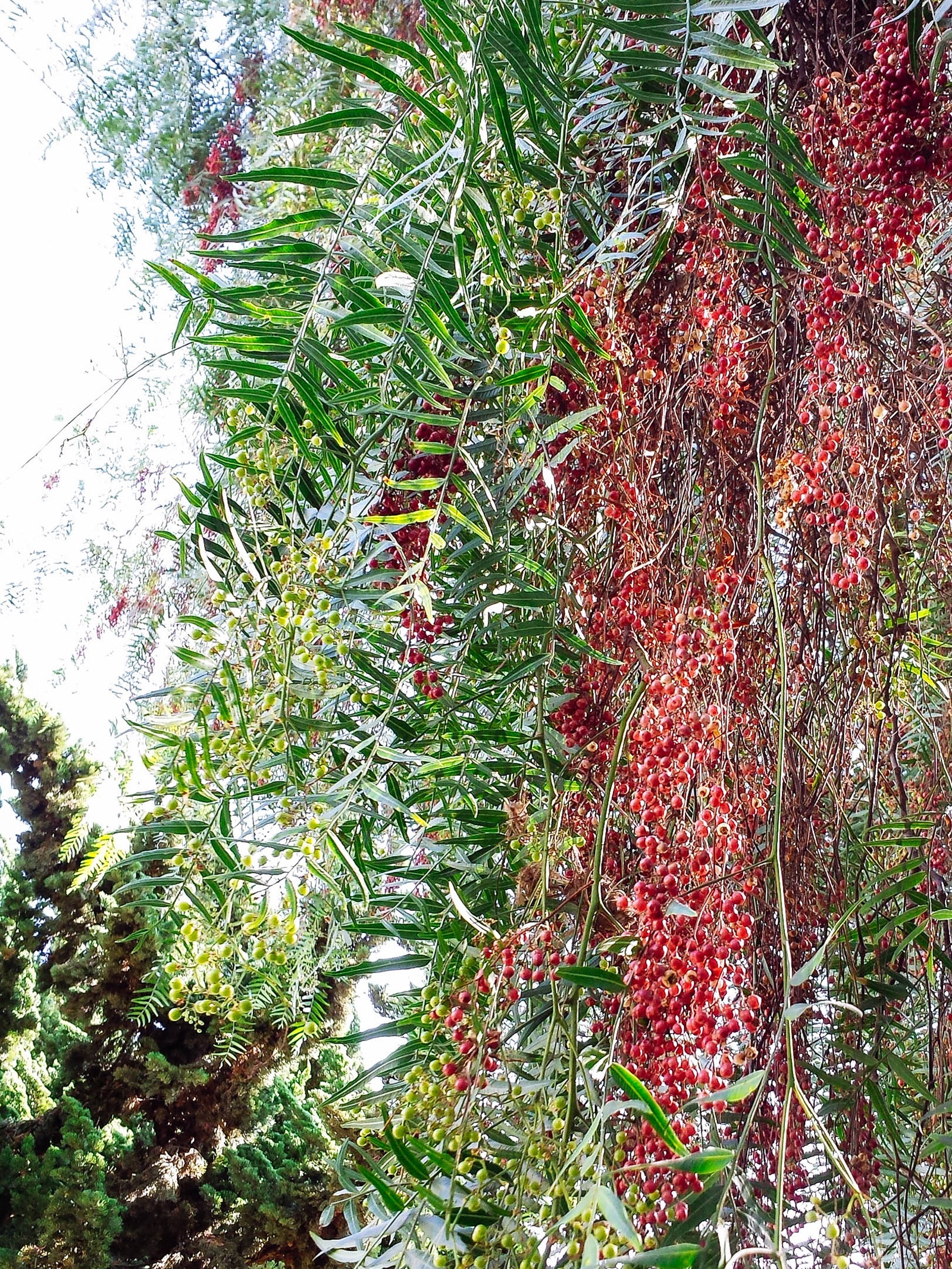
Where are Peruvian pink pepper trees found?
Peruvian pepper is an evergreen tree with a weeping canopy of branches, native to Northern Peru in the high desert of the Andes.
It’s become naturalized around the world, where it’s cultivated for spice production, and in some parts it’s even considered a serious weed—taking over savanna and grasslands in South Africa, and forests and coastal areas in Australia.
Peruvian pepper likes hot climates and can be found in the Southwest (Arizona and Southern California), Northern and Central California, Texas, Louisiana, Florida, Hawaii, and Puerto Rico.
In Southern California where I first encountered them, Peruvian pepper trees grow wild all over the Palos Verdes Peninsula, as well as the Greater Los Angeles inland valleys and foothills.
I’ve foraged berries from my former backyard in the South Bay, my friend’s backyard in Long Beach, and from Piru Creek in Northern Los Angeles County. You can even find rows of pepper trees lining the streets around Disneyland in Anaheim!
The leaves and flowers of Peruvian pepper trees have a subtle peppery aroma. In spring and summer, tiny, delicate flower buds dot the branches. In fall and winter, the flowers give way to reddish-pink berries that are ready for harvest.
With Peruvian pepper trees ripening in fall and winter, the end (or beginning) of the year is the perfect time to start foraging!
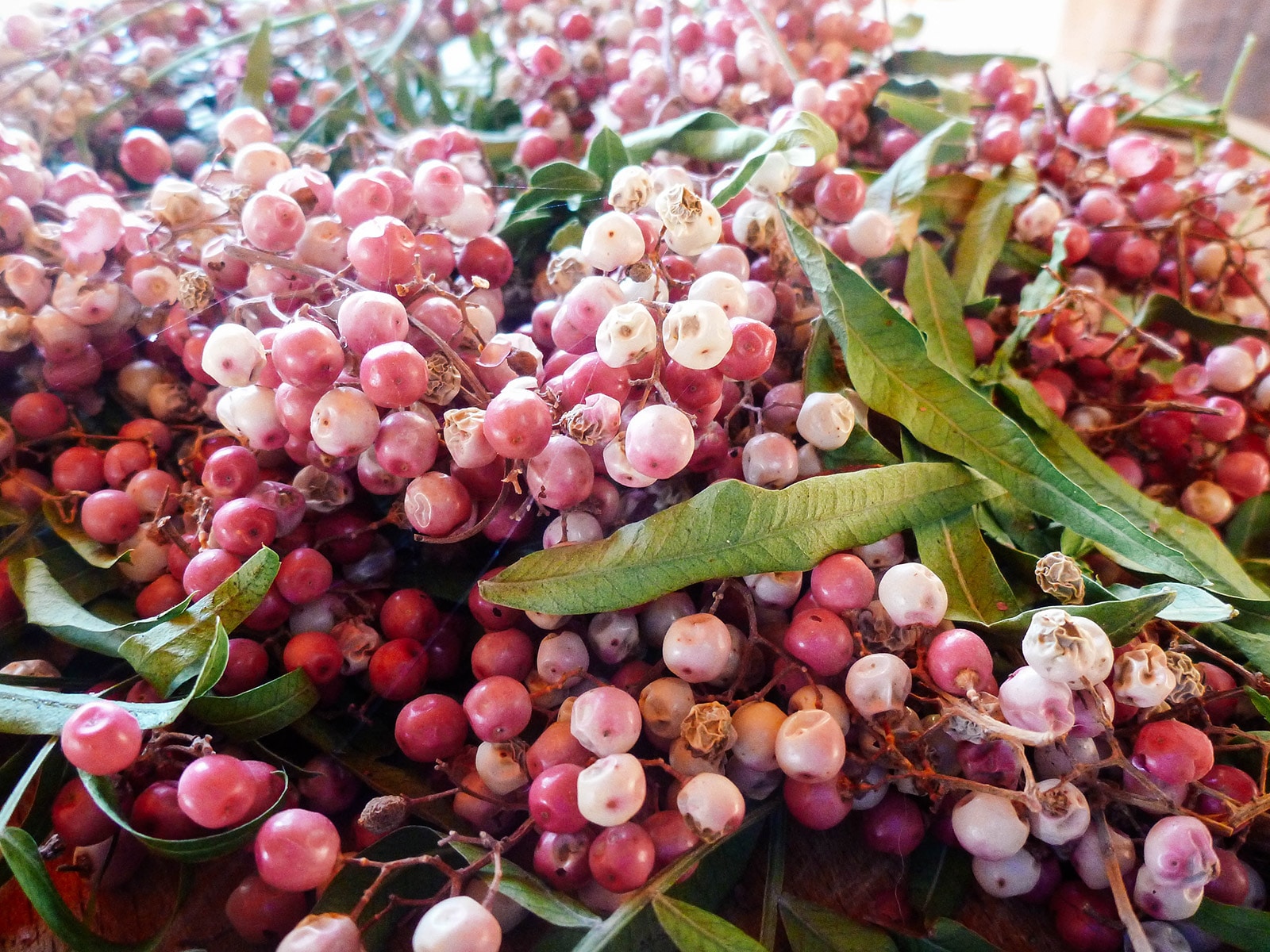
How to harvest the peppercorns
Harvesting pink peppercorns is as simple as collecting a few clusters of berries from a Peruvian pepper tree.
Step 1: Look for branches with ripe pepper tree berries.
Cut off a segment of branch with a good amount of reddish-pink berries on it. They’re easy to find as they’re usually the clusters draping off the ends of the tree.
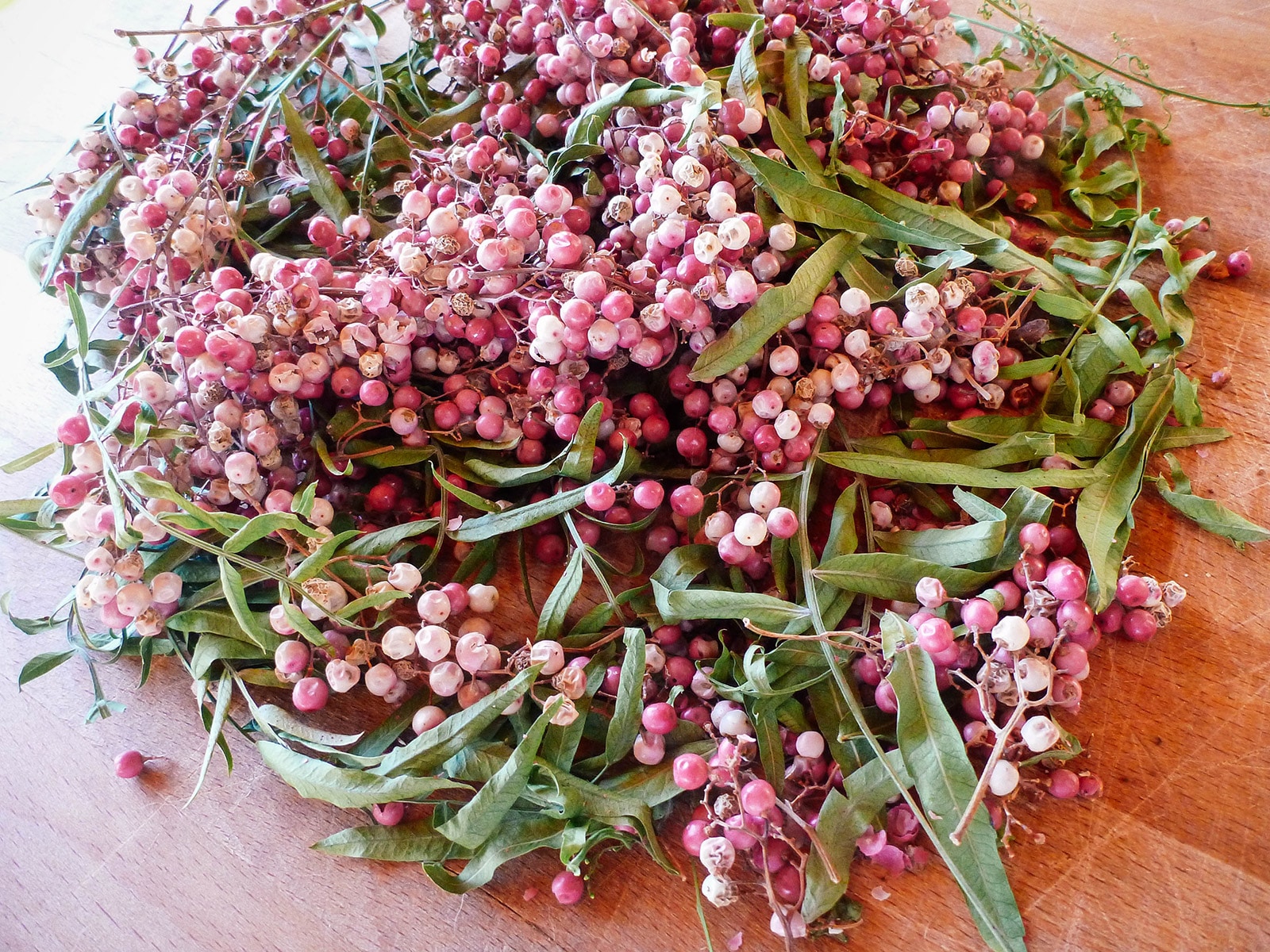
Step 2: Dry the peppercorn berries.
Gently pull the fresh berries off the branches with your fingers. Sometimes I’m able to do this quickly by running my fingers firmly down a branch to strip off the berries (the way you might take thyme or rosemary leaves off a stem).
Don’t worry if you get some stems in the mix—though it won’t give you a “clean” harvest, there’s no harm in having a few bits and pieces of stems in with your spice.
Spread the berries out on a plate or cookie sheet, and leave them out on the counter to dry at room temperature.
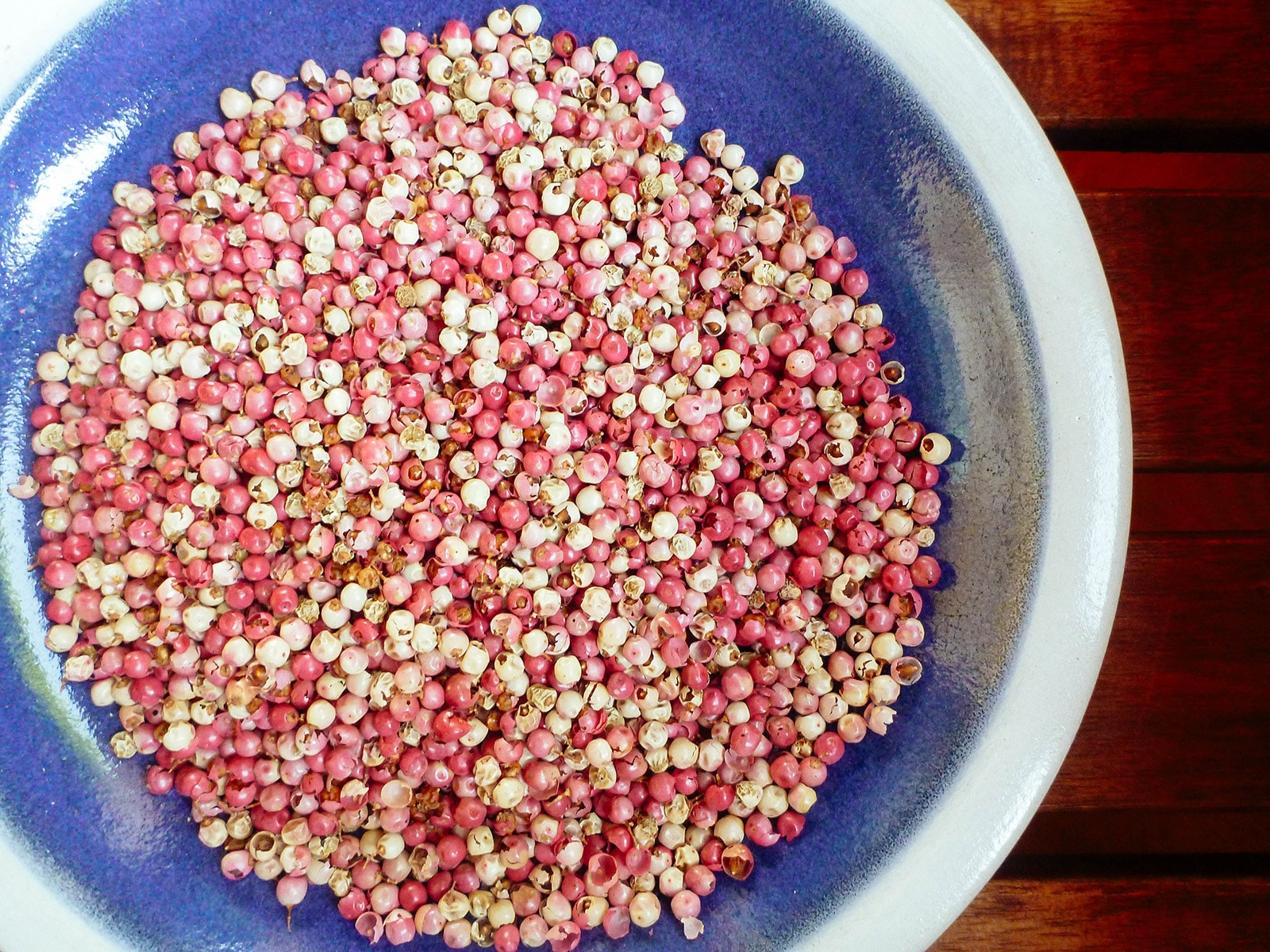
Within a few days, the berries will fully dry and harden into peppercorns.
A Peruvian pepper berry consists of a shell surrounding a single seed. During the drying process, the shell may crack and separate to reveal a brownish pink seed inside.
This separation is similar to how white peppercorns are made—the outer shells are removed from the berries of black pepper plants and the seeds themselves become white peppercorns.
If your berries are dried in a sunny spot, the shell may become bleached as it shrinks around the seed to create the hard, wrinkled outer layer so familiar as peppercorns.
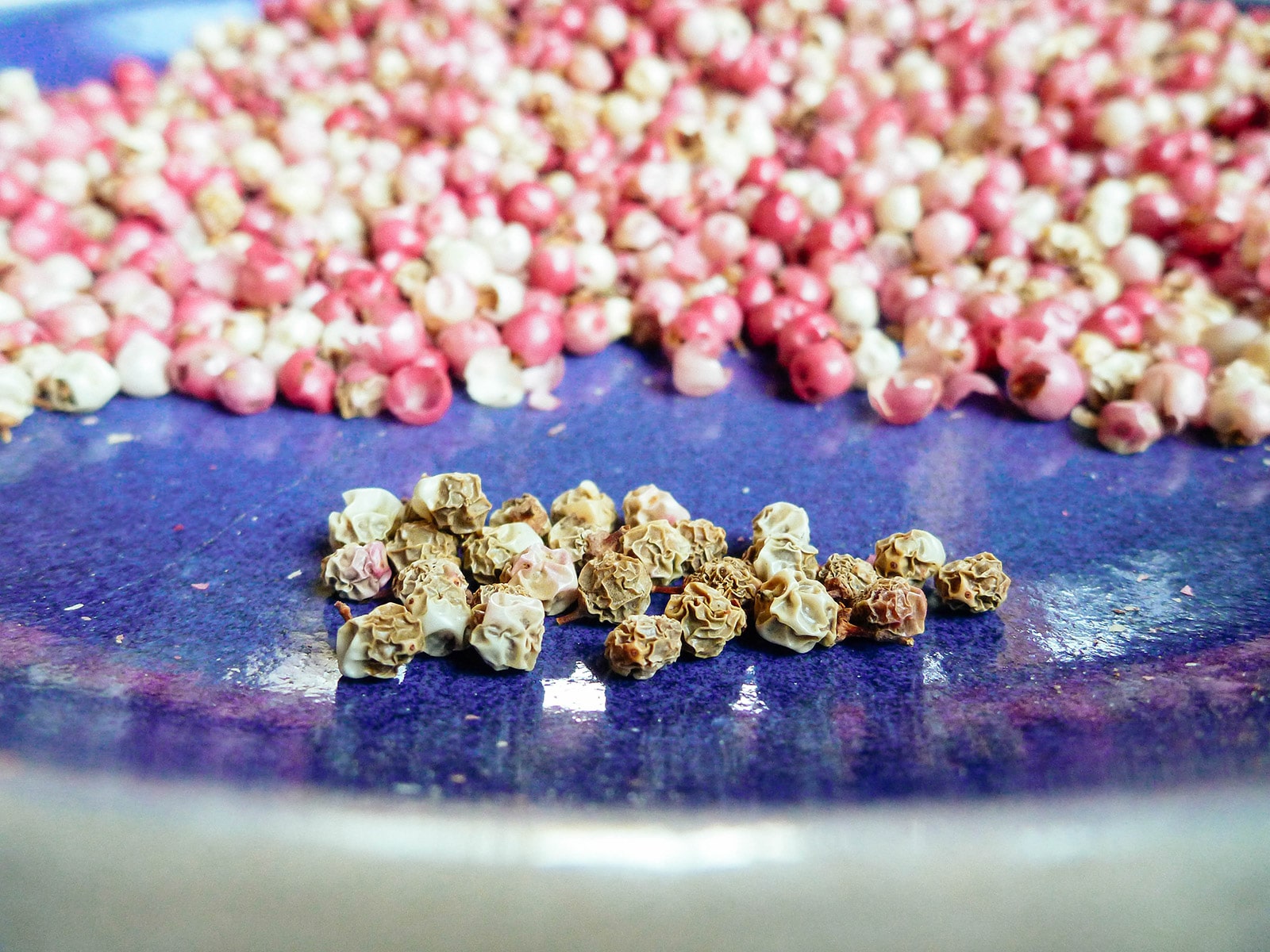
Sometimes the shell stays intact and you’ll have smooth peppercorns, but you can eat any of these pink peppercorns (shelled or not).
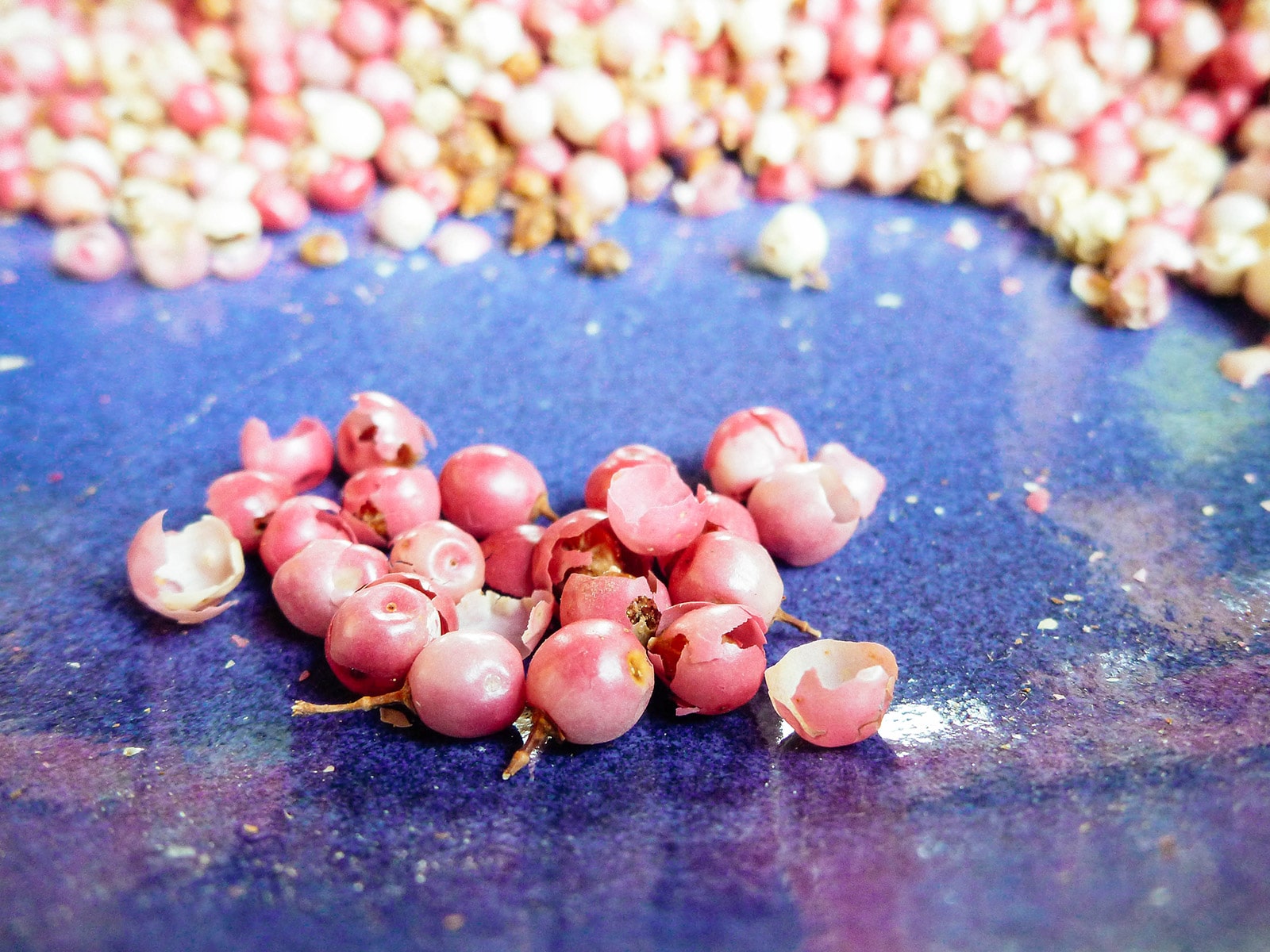
What can you do with pink peppercorns?
Because of their delicate, paper-thin skins (which tend to get stuck in a traditional pepper grinder), I like to grind my pink peppercorns with a mortar and pestle, or crush them with the flat side of a heavy knife to release their oils.

I don’t blend them with black and green pepper (the way you typically see pink peppercorns sold in the store), as I feel true pepper overwhelms them.
Pink peppercorns taste differently than black peppercorns. They have a fruity and slightly spicy profile (like mild chile peppers) that complements seafood, salads, curries, cheese, chocolate, or popcorn.
Since Peruvian pink peppercorns are relatively mild, they can be used whole in recipes without being too overpowering. They’re still spicy and peppery, but have a very fragrant, sweet-tart and rosy tone.
The flavor would work well in light sauces, fruity vinaigrettes, or desserts. I think I’ll even try them in place of black peppercorns in my pickling spices, especially when I want a bit more sweetness.
Make this: 4 easy ways to pickle green tomatoes
As with any spice, pink peppercorns should be stored away from direct sunlight and heat to preserve flavor. It will keep for at least six months, after which it may start to decline in quality (which simply means you’ll have to use more of it to get the same potency as freshly dried pink peppercorns).
Read next: Organize your spice drawer with my simple DIY hack
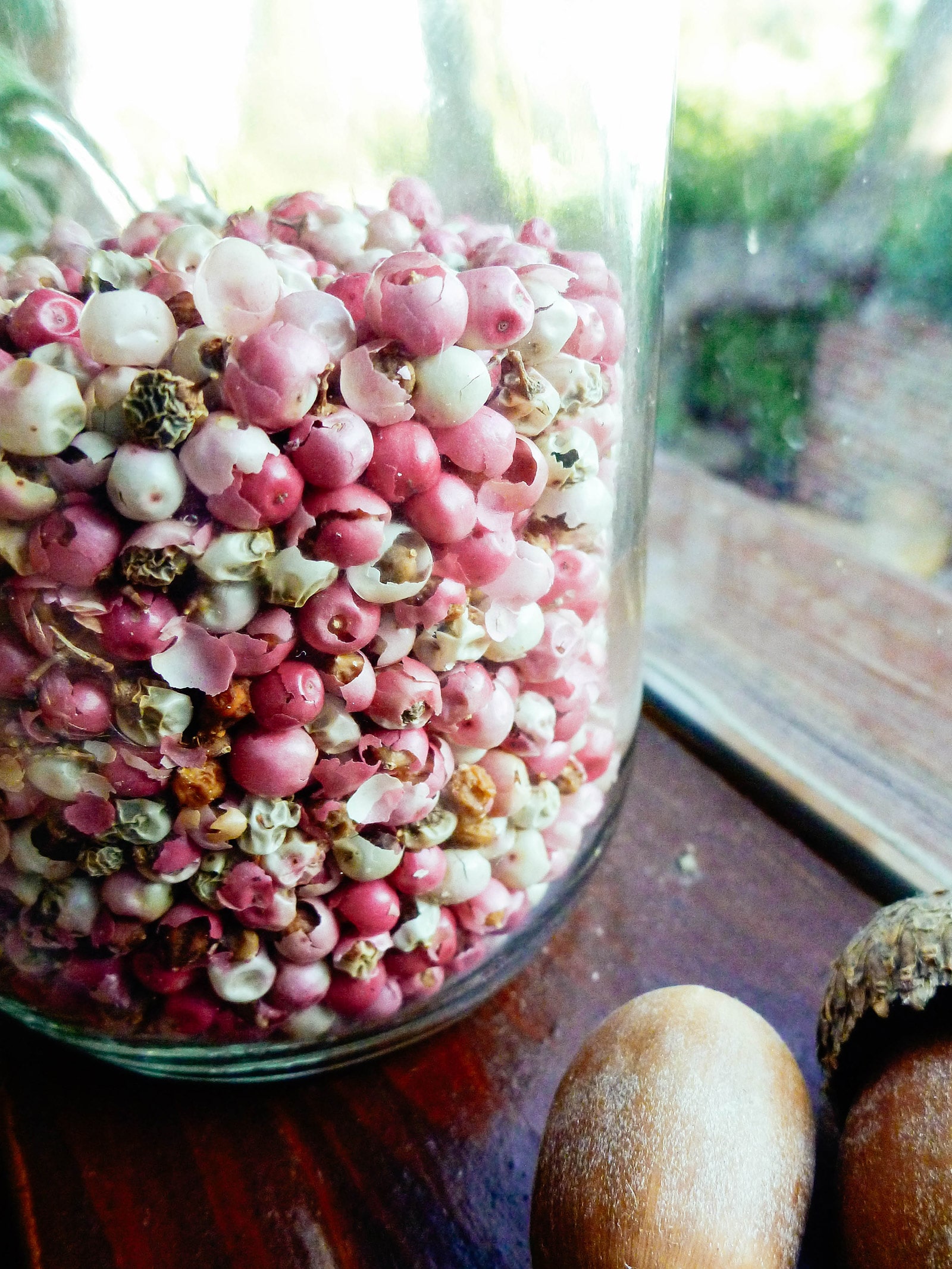
Are pink peppercorns toxic?
Here’s an interesting chapter in the pink peppercorn tree’s family history that most people don’t know…
The Peruvian pepper tree belongs to Anacardiaceae, otherwise known as the cashew family, a group that also includes poison sumac, poison oak, and poison ivy. Pink pepper’s connection to this notorious family means it earned a bad rap in the 1980s for being a potentially toxic plant.
That’s because the Brazilian pink pepper was once banned from importation after the Food and Drug Administration received reports of consumers having adverse reactions to the berries.
It enjoyed a brief moment in the culinary spotlight when it was introduced in 1980, hailed as an emblem of French nouvelle cuisine.
But researchers soon began documenting cases of human toxicity including “violent headaches, swollen eyelids, shortness of breath, chest pains, sore throat, hoarseness, upset stomach, diarrhea, and hemorrhoids,” symptoms that are consistent of those with poison ivy reactions, according to this 1982 article by The New York Times.
The French government protested the FDA ban, insisting that pink peppercorns grown and imported from the island of Réunion, near Madagascar, were non-toxic due to the trees growing on different soil under different conditions.
With uncertainty on whether or not they’d poison their customers, chefs stopped cooking with pink peppercorns, markets stopped selling them, and the once-trendy spice fell out of public favor by 1983.
The French eventually submitted research that proved their Brazilian pink peppercorns were non-toxic, and the FDA dropped its ban. Rainbow peppercorn blends gradually made their way into shops and kitchens again, with few answers to explain the spate of severe reactions that were previously documented.
Today, it’s believed that allergic reactions are limited to people who are allergic to tree nuts (since pink pepper trees come from the cashew family) or those who are sensitive to the sap of poison ivy.
What’s not known is how much of the spice one has to ingest in order to experience any ill effects. Most people don’t chew on handfuls of pink peppercorns at a time, so with the tiny amounts used in cooking, it’s unlikely to cause reactions in those without serious allergies to related plants.
In addition, there have been no documented cases of people experiencing reactions to Peruvian pink pepper. It’s widely enjoyed these days in all types of cuisine, whether the peppercorns are purchased from a store or foraged from a tree.
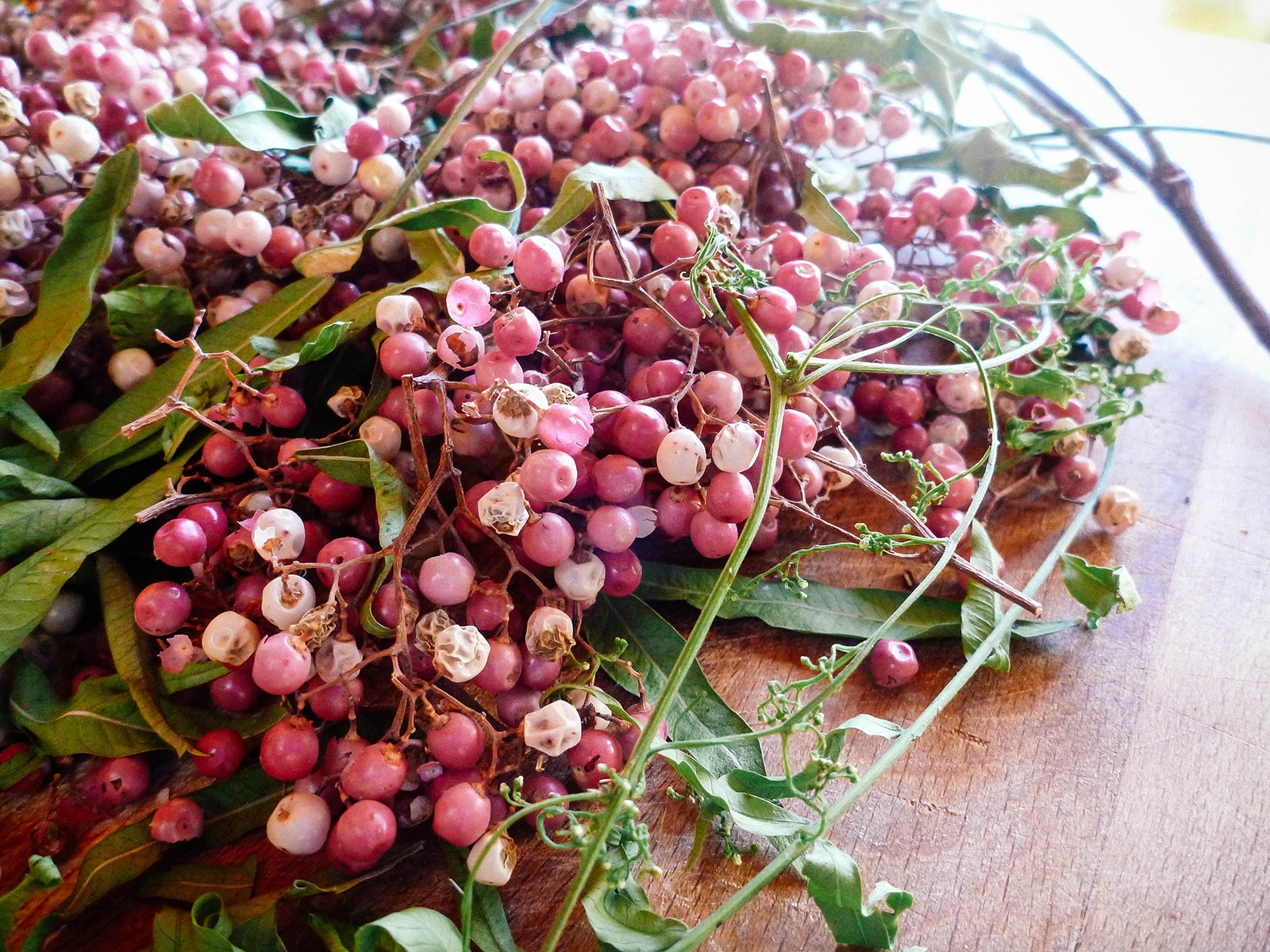
Do you have a pink pepper tree growing in your yard? Or do you live in an area where pink pepper trees grow in abundance? Please share where you’ve seen them!
This post updated from an article that originally appeared on November 10, 2011.


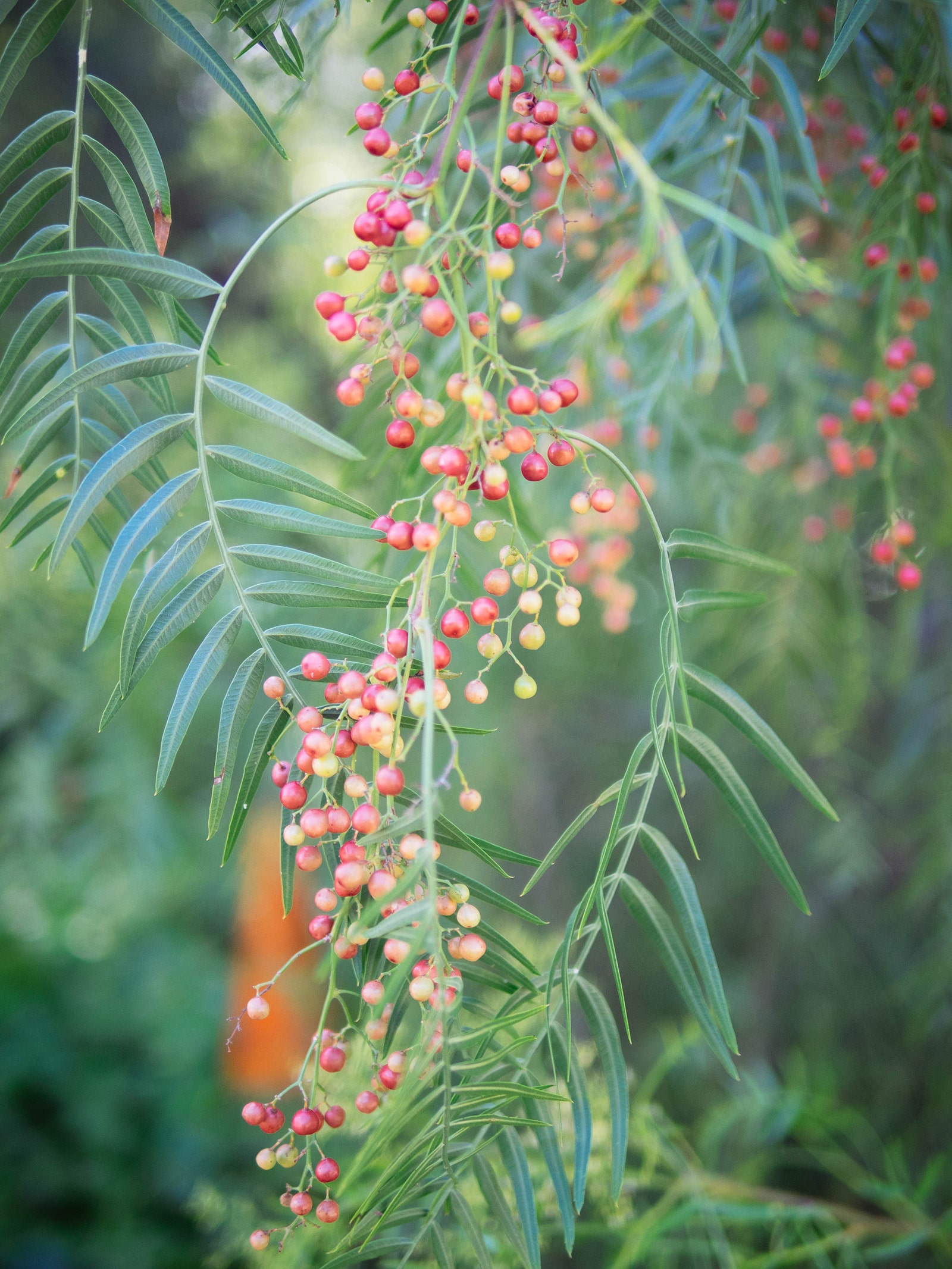
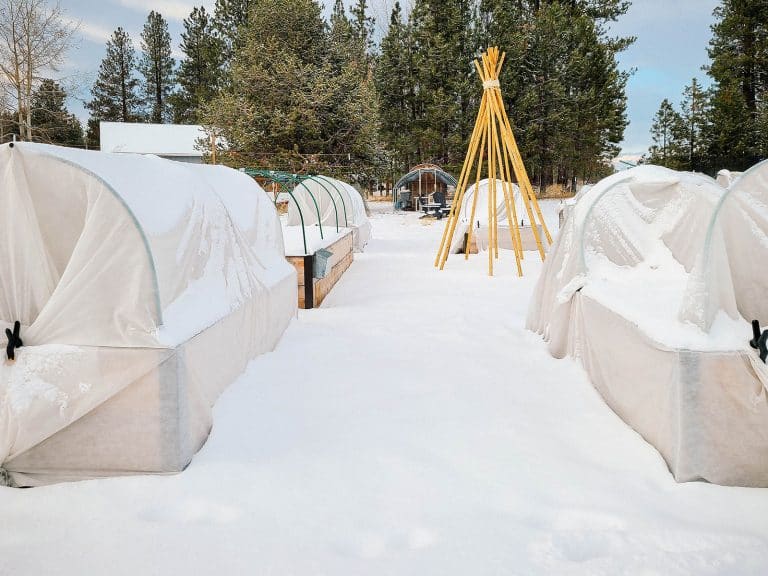


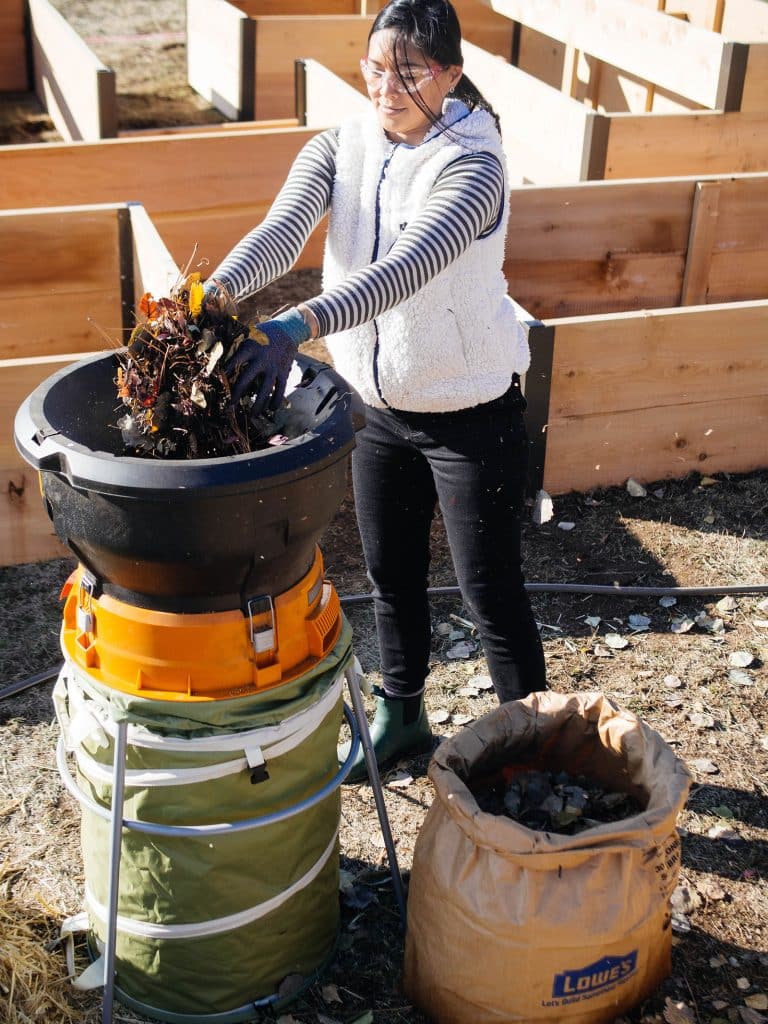







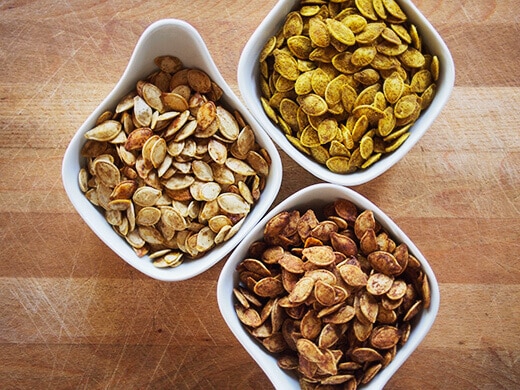

I am still somewhat unsure of the difference between the Peruvian and the Brazilian pepper tree. I have a Brazilian pepper tree. Do I harvest, process, and use the berries in the same way as the Peruvian pepper berries?
Thank you,
Patricia Burney
Yes, you can harvest, dry, and use the berries from a Brazilian pepper tree the same way.
Can you brine the young green ones before they turn pink? I want to use them whole/soft for pepper steak cream sauce.
I honestly don’t know if the unripe green berries of Schinus are edible. Green peppercorns (that you buy from a store) are the unripe fruit of true pepper (Piper nigrum), so they are completely different from pink peppercorns.
I replied to Teresa of South Australia,
The original rental agreement on my 170 year old house stipulated a yearly payment of one pepper corn payable on the 25th of March each year for 21 years. The property has many Peruvian pepper corn trees to ensure the rent was paid.
I was excited to know about growing a pink peppercorn tree in my backyard until I saw that it grew in Southern California. I live way too far north for that. Then I thought, I have a green house. I can grow a little tree for my own use. Then I saw that pink peppercorns are in the cashew family and I am grateful that pink peppercorns are so expensive in the store that I have never bought them before. My son is super allergic to cashews and I might not have figured out what the source of his allergic reaction was if I had used it in a meal! Talk about a rollercoaster of emotions reading this article
I am glad to have this information! Thank you for writing this article!
Just came across (Peruvian) pink peppercorns while volunteering with a gleaning activity as part of forestr.org in the SF East Bay (50% of the gleaned produce is offered to the private landowner, and of the rest, 90% goes to food banks, volunteers get to keep the rest). The trees are next to a highway on land owned by Cal Trans. Thank you for the suggestions of when to harvest, how to harvest, the relationship to anacardos and how to use them. I’m tempted to try a cashew in pink peppercorn curry.
I have three of these trees at my house in Murrieta, CA – two are in my backyard. And let me tell you, they are messy! I constantly have to keep the trees trimmed to stop them from dropping leaves and twigs and berries in my pool and destroy the filter. But they sure do have a lovely peppery scent! I might consider keeping them around awhile and take advantage of their offerings
Look for a gleaning volunteer group or a food bank near you. They’ll offer you up to 50% of the gleaned produce, and donate the rest to foodbanks or the volunteers. In our case, the foodbanks weren’t interested in the peppercorns, so each volunteer kept a few sprigs for our own use.
I have a pink peppercorn tree in my yard. ( San Diego Ca. )My son that is a chef, told me I could harvest and use them in cooking. Thanks for your article. It was very helpful. I will try it out this season.
Hi! Great article, thanks! We have one on our land in the Algarve, Portugal and I’m harvesting it right now!
Thank you for the info! I’m new to pink pepper though I’ve always liked it in pepper mixes. I just learned alot of relevant information all at once and I just love that! What I want to know is: does Peruvian pepper taste different than Brazilian or have different medicinal value? And how does the medicinal value of pink pepper compare with black pepper? I know that black pepper is used to make other medicinals more bioavailable, like tumeric. Also, I live in Colorado, between Grand Junction and Aspen, (Paonia), do you know if I can grow Peruvian pepper here? And how do I get a plant or can I grow it from the seeds? I have never seen it in catalogs but I would really love to grow one!
I live in California, near my house there is a park named Shabarum park, there are many Peruvian pink peppercorn trees , I garnished some , so search Goggle and found this article . Now I may keep this peppercorn for decor only . Probably not worthy to cause allergies to my kitchen guests.
I appreciated this article . Ty .
Thank you for this article! I live in a small village in Lanzarote, Canary Islands on a tree lined street known for its “eucalyptus” trees … I just realised I’m fairly certain they are in fact pink peppercorn x
I’ve just found them in Fuerteventura too
Thanks Linda for the informative article and photos. Looks like in June the OC (Orange County, CA) these berries are ready to harvest which is summer for us but fall/winter in South America. Right now, they have the appearance of the berries seen in the photos, so I am not sure when to harvest. Right now raw, they taste sharp/aromatic. Sincerely, Dwayne
Thank you so much for such an informative article on collecting the pink peppercorns. I planted a Schinus molle tree in my yard 4 years ago and made sure to water it religiously for the first two years and now its over 15 feet tall with masses of pink pepper berries. They are beautiful tree and every bit as graceful as a willow, casting dappled shade from the late afternoon sun on my patio.
I live in the South of France and this tree (called a ‘Faux poivrier’ in French) is as common here as it is in California.
This is a very interesting article. I live in South Australia where the climate is similar to Mediterranean. We have a number of pepper trees on our property and this year I have decided to pick the berries. Am looking forward to trying in cooking later after drying.
Unfortunately the roots from these trees are very invasive and have caused a lot of damage by lifting the pavers around our house so we have needed to cull those too close to the house.
I’ve been enjoying my annual Christmas present: a tin of Candy Cane tea from Silk Road. It’s a mixture of peppermint, Hibiscus flowers and pink pepper. So relieved to finally know why I couldn’t taste the pepper.
Don: Thanks for sharing this. We have all three growing in the back yard, will have to give it a shot. Dwayne
You should hook up with this guy for Pacific NW foraging: https://thenorthwestforager.com/2020/06/30/now-available-pocket-guide-to-wild-edible-plants/
Thanks for the recommendation!
I’m in Santa Barbara county, and there are quite a few of these in the park across from me. I used them in my wedding bouquet and I have a few branches decorating my home office!
That sounds so pretty!
I now live in central Mexico and the Peruvian Tree is everywhere. Like you, it reminds me of the weeping willow but with the added bonus of those lovely little pink beads!! I don’t think that the people here know that it can be eaten. I am definitely going to have to go pick some from the park around the corner!!
Thanks you,
Shelli
Enjoy them Shelli! I’m in Oregon now and sometimes I miss having such easy (and free!) access to pepper trees.
Hello. I wanted to see if you could help me identify what it mink is a pink peppercorn tree? The berries look like what you’ve shown in your article but the tree leaves are different. Can I send you a picture? Any advice would be greatly appreciated.
Peruvian pepper trees and Brazilian pepper trees have similar berries but different leaves. I wouldn’t want to misidentify a tree though. I suggest taking a sample to your local cooperative extension office or emailing them for help, as they’ll be more familiar with what grows in your area.
We have a couple trees around the corner I a vacant lot. I have always been afraid to eat them although I love the smell of them.
I will be harvesting some tomorrow!!
We also have carob trees by the dozens in town . I love getting the pods . My dogs love them for treats.
In Rancho Cucamonga, both the Peruvian and Brazilian trees are here.
Canary Islands!! Very tropical climate perfect for the growth of these wonderful little gems!
Hi Linda! Glad I found your article as I’ve been tossing up whether to take advantage of the abundance of pink pepper corn trees that grow around here in Australia. Would you still recommend buying them in a store or are they safe enough to take from the trees? Thanks! Imogen
I’m having trouble separating stem from berry. Ant tips?
Wait for the stems to dry out a bit, then put them in a brown paper bag and give a good shake… that might help separate the berries? (It’s how I sometimes collect flower seeds.)
Madagascar pink peppercorn is this the same thing?
Yes, same.
Kathy and I stayed at a VRBO rental outside Los Olivos last year that had a huge pepper tree in the yard. I took home several clusters and dried them out. Just like you said, I used a mortar and pestle and even though they were completely dried out, they gave off a lot of oil. I like that its adds something when I BBQ that people can’t seem to pin down.
I miss the pepper trees in California. 🙂 Need to plan a visit this winter to restock my pink pepper stash!
I live in Victoria Australia, and I have dozens of these trees on my property, we only realized what they were when my baby goat started eating the leaves, we looked up what sort of tree it was to make sure it wasn’t going to hurt my goat, and there you have it, we have dozens of Californian pepper trees
My home in Western Australia was built 170 years ago,
It’s called Ashworth homestead. The original land title hangs in the dinning room.
The prescribed rent is one pepper corn per year paid on or before the 25th of March each year
for 21years.
The property has many old Peruvian pepper trees presumably to ensure the rent got paid.
Just found some on the Canary Islands. Have just crushed a few…they smell amazing. Excited to use them in my cooking 🙂
Oh nice! Do you have the Peruvian or Brazilian kind on the Canary Islands?
Not sure. They look like the ones in your photo.
Peruvian. 🙂
Pepper trees grow/grew down the length of Euclid Avenue in Ontario/Upland California when I lived there. I don’t know if they are still there. Use to love the smell of them. I don’t know which variety they are.
I think they make beautiful landscaping trees. They grew all over the Palos Verdes Peninsula when I lived in SoCal, and I loved seeing them dripping with berries.
Hello, I’m pretty sure my trees are the Brazilian variety. Could you tell from a picture? Some sources say the Brazilian ones are poisonous.
The leaf shape is different between the Peruvian and Brazilian varieties. As to whether the Brazilian pepper tree is poisonous, it’s in the same family as poison ivy, so contact with any part of the tree can possibly cause the same reaction in people who are allergic.
Thank you for your suggestions. After harvesting them, had no idea how to use them so this is very concise. Excited to try them. Thanks!
Has anyone found a way to easily clean the peppers from the surrounding brittle branches? (I’m beginning to think the shockingly high cost of pink peppercorns is because of the effort required to clean them.)
I pull or shake them off the branches by hand pretty easily, but if you look at my pictures, you’ll see that sometimes a few stems remain. It’s never been an issue, flavor-wise.
HA. I just started doing this and wanted to look up an easier way to strip them. Eric, I think you’re right. This is a pain in the a**
Did you wash them first? What’s the easiest way to get the peppercorns off the stem?
No, I don’t wash them (and you don’t have to either, assuming your tree is wild or grown without pesticides). To get the peppercorns off the stems, I just run my hand down the stem and strip them off in one swoop. They come off very easily. Here’s a post I wrote about harvesting the berries: http://gardenbetty.com/2011/11/peruvian-pink-peppercorns/
Thank you for your help! I touched them to arrange them in a vase and so far so good.
Brilliant minds think alike…I just posted about a pepper tree too, I think mine is a Brazilian since it doesn’t droop like a Peruvian or Californian…what to you think…inquiring minds want to know… http://thefolia.com/2014/12/01/gather-around-the-pepper-tree/
Definitely a Brazilian pepper tree! You can harvest peppercorns from that variety as well.
Thank you that’s what I thought, I was hesitant about trying it because of the possibility of an allergic reaction.
Both Schinus species can cause allergic reactions in people who are sensitive to members of the cashew or sumac family, but since you use so little of it as a spice, you may or may not react to pink pepper. Best to consult an allergist on this.
Beautiful images! Thanks for sharing! All the pepper berry trees in Irvine California are blooming. the blossoms are sweet and fragrant and delicious. That said, I can’t find any info on whether or not I should be eating these little blossoms. They’re great in potato salad. Have you read anything?
I’ve never tried pepper berry flowers, but since we do eat the fruit (the pepper berries themselves) then I’d assume the flowers are edible as well.
Thank for a clear and consice explanation of how to harvest these red berries. Good thing you mentioned their affinity to cashews. My daughter is highly allergic so I’ll have to monitor how and when I use them. As in Anaheim, the city of Upland lined their main corridor , Euclid, with this tree. Many thanks!
I am in Australia and we have heaps of the “Pink pepper” trees everywhere even here on Kangaroo Island have just picked my first bunch can’t wait to try them
I see you posted this a while ago, but thank you so much for doing so. I live in South Africa and just found a TON of these but the locals said they don’t eat them. I picked them and wanted to cook with them but wasn’t sure they were what I thought they were! Amazing!
Seeing as these trees are so invasive in South Africa, the locals probably aren’t keen on eating “weeds.” Their loss, your gain!
C’est magnifique. Bonne journée.
Makes me miss So Cal! Love the blog and can’t wait to hear all about those chickens!
Thanks Melissa! Let me know when you come out for a visit, I’ll give you a coop tour. 🙂